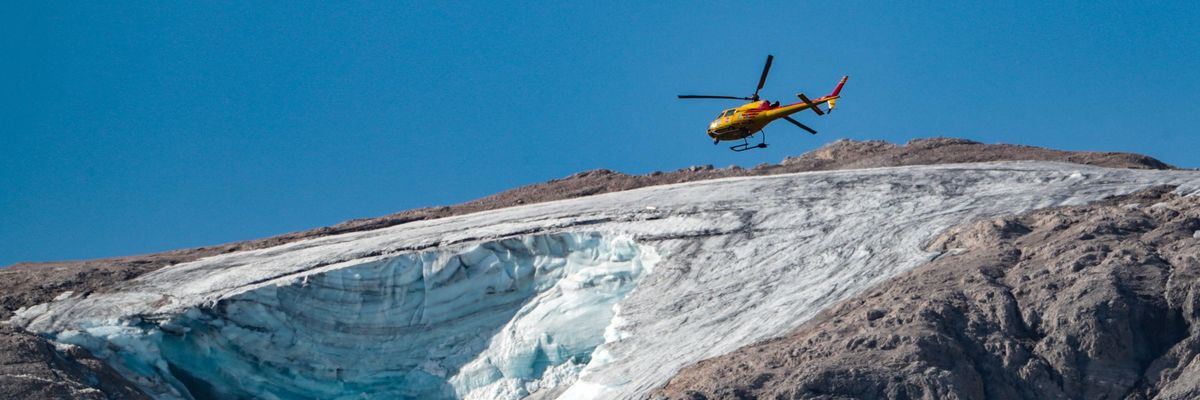
A rescue helicopter flies on July 4, 2022 over a glacier that collapsed the day before on the mountain of Marmolada, the highest in the Dolomites, one day after a record-high temperature was recorded at the glacier's summit in the Italian Alps. At least six people were killed when the glacier collapsed. (Photo: Pierre Teyssot/AFP via Getty Images)
Deadly Glacier Collapse in Italy 'Linked Directly to Climate Change'
At least seven people were killed when a glacier slid down a mountainside near a popular climbing route in the Alps on Sunday.
Italian Prime Minister Mario Draghi joined scientists in pointing to the climate emergency as the cause of a deadly glacier collapse in the Italian Alps on Sunday afternoon, saying policymakers must act to ensure avalanches don't become a more regular occurrence.
The collapse of the glacier in the Marmolada mountain range in the Dolomites "certainly depends on the deterioration of the environment and the climate situation," Draghi said at a press conference following the disaster, which was confirmed Monday to have killed at least seven people.
"Combined with the unusually high temperatures across the region over the summer, glaciers are melting fast."
"Today Italy weeps for these victims," the prime minister added. "But the government must think about what has happened and take steps to ensure that what happened is unlikely to do so again or can even be avoided."
In addition to those killed, at least eight people were injured by the collapse, which happened near a popular climbing route, and 14 were still missing as of this writing.
A huge chunk of the glacier broke off and slid down the mountain during a heat wave that's hit the region earlier in the year than normal. Meteorologists have recorded temperatures of 50deg Fahrenheit in the Marmolada mountain group in recent days.
Jonathan Bamber, director of the Bristol Glaciology Center at University of Bristol in the United Kingdom noted that the Dolomites "experienced a drought throughout the winter with very little snowfall."
"Combined with the unusually high temperatures across the region over the summer, glaciers are melting fast," he said, adding that high European mountains are "an [increasingly] dangerous and unpredictable environment to be in."
Poul Christoffersen, a professor of glaciology at the University of Cambridge, called the collapse "a natural disaster linked directly to climate change."
"High elevation glaciers such as the Marmolada are often steep and relying on cold temperatures below zero degrees Celsius to keep them stable," he explained. "But climate change means more and more meltwater, which releases heat that warms up the ice if the water re-freezes, or even worse: lifting up the glacier from the rock below and causing a sudden unstable collapse."
Water at the base of the glacier "and increased pressure in water-filled crevasses are probably the main causes for this catastrophic event," said the Alpine-Adriatic Meteorological Society.
\u201cThe footage of the large ice avalanche in Marmolada today in close proximity.\n\nWe don't know the author, we will write it in the comments as soon as we will know it.\n\nIndeed an impressive sequence\u201d— Alpine-Adriatic Meteorological Society (@Alpine-Adriatic Meteorological Society) 1656859733
The United Nations Intergovernmental Panel on Climate Change (IPCC) warned in a recent report that melting ice and snow is one of 10 major threats that humans will need to contend with due to the climate crisis.
The glacier that collapsed Sunday shrank by 30% between 2004 and 2015 according to a 2019 study by the National Research Council in Italy.
An Urgent Message From Our Co-Founder
Dear Common Dreams reader, The U.S. is on a fast track to authoritarianism like nothing I've ever seen. Meanwhile, corporate news outlets are utterly capitulating to Trump, twisting their coverage to avoid drawing his ire while lining up to stuff cash in his pockets. That's why I believe that Common Dreams is doing the best and most consequential reporting that we've ever done. Our small but mighty team is a progressive reporting powerhouse, covering the news every day that the corporate media never will. Our mission has always been simple: To inform. To inspire. And to ignite change for the common good. Now here's the key piece that I want all our readers to understand: None of this would be possible without your financial support. That's not just some fundraising cliche. It's the absolute and literal truth. We don't accept corporate advertising and never will. We don't have a paywall because we don't think people should be blocked from critical news based on their ability to pay. Everything we do is funded by the donations of readers like you. Will you donate now to help power the nonprofit, independent reporting of Common Dreams? Thank you for being a vital member of our community. Together, we can keep independent journalism alive when it’s needed most. - Craig Brown, Co-founder |
Italian Prime Minister Mario Draghi joined scientists in pointing to the climate emergency as the cause of a deadly glacier collapse in the Italian Alps on Sunday afternoon, saying policymakers must act to ensure avalanches don't become a more regular occurrence.
The collapse of the glacier in the Marmolada mountain range in the Dolomites "certainly depends on the deterioration of the environment and the climate situation," Draghi said at a press conference following the disaster, which was confirmed Monday to have killed at least seven people.
"Combined with the unusually high temperatures across the region over the summer, glaciers are melting fast."
"Today Italy weeps for these victims," the prime minister added. "But the government must think about what has happened and take steps to ensure that what happened is unlikely to do so again or can even be avoided."
In addition to those killed, at least eight people were injured by the collapse, which happened near a popular climbing route, and 14 were still missing as of this writing.
A huge chunk of the glacier broke off and slid down the mountain during a heat wave that's hit the region earlier in the year than normal. Meteorologists have recorded temperatures of 50deg Fahrenheit in the Marmolada mountain group in recent days.
Jonathan Bamber, director of the Bristol Glaciology Center at University of Bristol in the United Kingdom noted that the Dolomites "experienced a drought throughout the winter with very little snowfall."
"Combined with the unusually high temperatures across the region over the summer, glaciers are melting fast," he said, adding that high European mountains are "an [increasingly] dangerous and unpredictable environment to be in."
Poul Christoffersen, a professor of glaciology at the University of Cambridge, called the collapse "a natural disaster linked directly to climate change."
"High elevation glaciers such as the Marmolada are often steep and relying on cold temperatures below zero degrees Celsius to keep them stable," he explained. "But climate change means more and more meltwater, which releases heat that warms up the ice if the water re-freezes, or even worse: lifting up the glacier from the rock below and causing a sudden unstable collapse."
Water at the base of the glacier "and increased pressure in water-filled crevasses are probably the main causes for this catastrophic event," said the Alpine-Adriatic Meteorological Society.
\u201cThe footage of the large ice avalanche in Marmolada today in close proximity.\n\nWe don't know the author, we will write it in the comments as soon as we will know it.\n\nIndeed an impressive sequence\u201d— Alpine-Adriatic Meteorological Society (@Alpine-Adriatic Meteorological Society) 1656859733
The United Nations Intergovernmental Panel on Climate Change (IPCC) warned in a recent report that melting ice and snow is one of 10 major threats that humans will need to contend with due to the climate crisis.
The glacier that collapsed Sunday shrank by 30% between 2004 and 2015 according to a 2019 study by the National Research Council in Italy.
Italian Prime Minister Mario Draghi joined scientists in pointing to the climate emergency as the cause of a deadly glacier collapse in the Italian Alps on Sunday afternoon, saying policymakers must act to ensure avalanches don't become a more regular occurrence.
The collapse of the glacier in the Marmolada mountain range in the Dolomites "certainly depends on the deterioration of the environment and the climate situation," Draghi said at a press conference following the disaster, which was confirmed Monday to have killed at least seven people.
"Combined with the unusually high temperatures across the region over the summer, glaciers are melting fast."
"Today Italy weeps for these victims," the prime minister added. "But the government must think about what has happened and take steps to ensure that what happened is unlikely to do so again or can even be avoided."
In addition to those killed, at least eight people were injured by the collapse, which happened near a popular climbing route, and 14 were still missing as of this writing.
A huge chunk of the glacier broke off and slid down the mountain during a heat wave that's hit the region earlier in the year than normal. Meteorologists have recorded temperatures of 50deg Fahrenheit in the Marmolada mountain group in recent days.
Jonathan Bamber, director of the Bristol Glaciology Center at University of Bristol in the United Kingdom noted that the Dolomites "experienced a drought throughout the winter with very little snowfall."
"Combined with the unusually high temperatures across the region over the summer, glaciers are melting fast," he said, adding that high European mountains are "an [increasingly] dangerous and unpredictable environment to be in."
Poul Christoffersen, a professor of glaciology at the University of Cambridge, called the collapse "a natural disaster linked directly to climate change."
"High elevation glaciers such as the Marmolada are often steep and relying on cold temperatures below zero degrees Celsius to keep them stable," he explained. "But climate change means more and more meltwater, which releases heat that warms up the ice if the water re-freezes, or even worse: lifting up the glacier from the rock below and causing a sudden unstable collapse."
Water at the base of the glacier "and increased pressure in water-filled crevasses are probably the main causes for this catastrophic event," said the Alpine-Adriatic Meteorological Society.
\u201cThe footage of the large ice avalanche in Marmolada today in close proximity.\n\nWe don't know the author, we will write it in the comments as soon as we will know it.\n\nIndeed an impressive sequence\u201d— Alpine-Adriatic Meteorological Society (@Alpine-Adriatic Meteorological Society) 1656859733
The United Nations Intergovernmental Panel on Climate Change (IPCC) warned in a recent report that melting ice and snow is one of 10 major threats that humans will need to contend with due to the climate crisis.
The glacier that collapsed Sunday shrank by 30% between 2004 and 2015 according to a 2019 study by the National Research Council in Italy.

